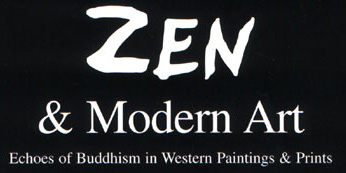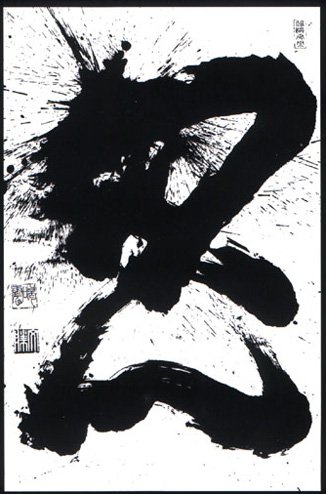
|
This exhibition is an introduction to the history of Zen influence on Western painting and printmaking. Many will be surprised by how widespread the influence has been. It followed after a general interest in Buddhism that in the late 19th century was more popular in the United States and Europe than most people realize. There are three parts to the exhibition. In the introductory galleries are traditional Zen artists of remarkable spontaneity such as Genko, Tesshu and Bunsho, along with indications of the first Western artists to be inspired by Buddhist art a century ago. This traditional Zen group includes Shunryu Suzuki Roshi, founding abbot of San Francisco's Zen Center, the first Zen monastery in America. The most famous work in the first gallery is a Zen circle, or enso, brushed by Suzuki Roshi. Rendered with a single stroke, the enso has for centuries been regarded as a quintessential Zen symbol. Representing the simultaneous reality of spirit and matter, everything and nothing, the spirit of this symbol has inspired many modern artists. In the middle galleries are European surrealists who matured during the 1920s and '30s, such as Joan Miro, S.W. Hayter and Gordon Onslow Ford, as well as Mark Tobey and Morris Graves, then abstract expressionists such as Jackson Pollock, Willem de Kooning, Robert Motherwell, and Franz Kline. Partly under oriental influence, these Americans made new modes of expression with abstract spontaneous gestures during the 1940s and '50s. Zen influence on artists was especially strong during this period. Then followed the popular Zen boom of the 1960s and '70s.
|
 Kasumi Bunsho Roshi |
|
The last galleries focus on notable figures of the San Francisco Bay Area such as Sam Francis, one of the first Bay Area artists to gain an international reputation, Lawrence Ferlinghetti, the poet-painter who became the Poet Laurate of San Francisco, Sabro Hasegawa, who introduced Zen art to many painters in San Francisco and New York, and Alan Watts, who introduced Zen to thousands of people by means of books, radio and television. Watts also taught at the legendary Academy of Asian Studies in San Francisco, as did Hasegawa and the Zen master Hodo Tobase. What took place at this unique graduate school of East-West studies contributed to the history of American culture. In the popular press, San Francisco came to be called the capital of new consciousness, as many young people turned away from materialism and consumerism toward ancient wisdom. Some think the influence of Zen on art, poetry, and music in the Bay Area disappeared after the Zen boom. Actually, that influence has remained very much alive. Suggesting the range of this continuing dynamic is work made in Oakland during the 1980s by John Cage who transmitted the spirit of Zen to generations of musical and visual artists, as well as work by the painter-scholar Kasuaki Tanahashi, who lives in Berkeley and is one of the best known Zen artists alive today. There were many degrees of Zen influence, some superficial, some deep. Some were only formal influences. Some did not go beyond a fascination with the artistic potential of spontaneous brush-strokes to uncover the philosophy which animates this kind of brushwork. Some did. What did they find? Buddhists understand we do not have to die to find lasting peace inside ourselves, that each of us can realize our Buddha-nature, our unconditioned consciousness, here and now. When this transformation of consciousness takes place, what changes occur? How are we different? We are enlightened. It is said that as enlightened individuals we are totally aware of the moment, no conceptualizing experience, but being fully present in every experience. Unattached, we stand firmly between the experience of everything and nothing, holding on to neither. We "kiss the joy as it flies," to quote William Blake. We continuously act directly, spontaneously, fearlessly and lovingly. According to the teachings of some Zen masters, selfishness will disappear, and our every thought, word and deed will be an act of love. We will work for the well-being of all humanity. This is not to suggest all the artists in this exhibition were enlightened. Most of them were not Buddhists, and did not practice traditional meditation. Very few were religious in any traditional way. They were reaching beyond tradition for new forms. However, most of these artists were engaged in a spiritual quest, a secular search for wholeness, and most of them regarded the process of making art as a kind of meditation. Zen was one of many spiritual inspirations for modernists over the decades, along with Alchemy, Tantra, Taoism, Theosophy, Shamanism, etc. In short, a majority of the artists in this exhibition did go beyond merely formal influences into the transpersonal psychology behind the forms. To one degree or another, they held up Zen goals as ideals and moved towards those ideals in their work by means of the meditative practice of making spontaneous gestures. Trying to set aside the rational side of their minds and trust the power of their intuition, the artists attempted to go beyond their mind-enclosed "egos" and compose spontaneously from a deeper dimension of consciousness. Some called this process "spontaneous unreasoning." They were not trying to imitate Zen art. Each of these artists took the idea of making spontaneous gestures in the direction of his or her own sensibility, as they searched for authentic being. Zen would have it no other way. While some forms of Buddhism stress deities, Zen does not. Therefore Zen is often referred to by some as a philosophy rather than a religion. The focus is on experience, not words or beliefs. The practice of Zen meditation might be thought of as a return to unconditioned awareness after a total transformation of the psychological structure of the mind. It was a struggle for some modern artists to become themselves, a great struggle. From a Freudian viewpoint, the "ego" and rationalizing mind does not give up control easily. The painting and calligraphy of Zen masters does not show signs of struggle, only pure spontaneity. They have moved past the monumental struggle to be free from they tyranny of the "ego". They are free. And they do not think of making works of art. They simply brush as naturally as they breathe. Western art, under the influence of Zen ideals and painterly techniques, primarily has been a record of painful, heroic efforts toward the finding of true freedom, sometimes with moments of luminosity breaking through. Lanier Graham, Director |
|